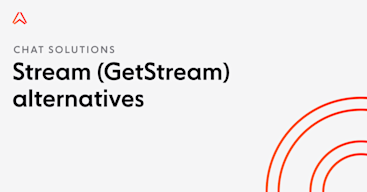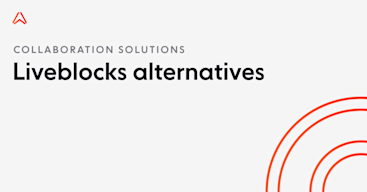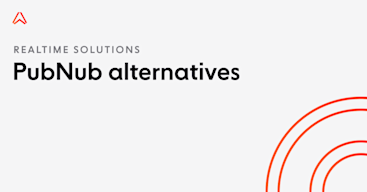- Topics
- /
- Realtime technologies
- /
- Amazon API Gateway pricing: What you need to know
Amazon API Gateway pricing: What you need to know
Amazon API Gateway is a managed cloud service that allows developers to create, maintain, secure, and monitor APIs. Whether you’re building small-scale applications or scaling up to enterprise-grade projects, understanding Amazon API Gateway’s pricing model is essential to managing costs effectively. Below, we break down Amazon API Gateway’s pricing structure and highlight key considerations to help you determine if it’s the right fit for your needs. (If you're looking for a more general breakdown of API Gateway against competitors, check out our dedicated alternatives page.)
How Amazon API Gateway pricing works
API Gateway operates on a pay-as-you-go consumption-based pricing model, with pricing scaling based on the number of API requests (HTTP, REST, or WebSocket) your application makes per month. The APIs you create with Amazon API Gateway can act as a “front door” to allow apps to access data and business logic and trigger functionality from your backend services, such as AWS Lambda, Amazon EC2, Amazon DynamoDB, and Amazon Kinesis. This makes API Gateway especially useful to those who want to stay in the AWS ecosystem.
However, several features of their pricing model may impact cost predictability and scalability. Here’s a detailed breakdown of API Gateway’s pricing features, and the cost-optimization features that could lead to a better deal for your data:
Pricing breakdown
Amazon API Gateway's offering | Why is this important? | |
|---|---|---|
Pricing model | Consumption-based API Gateway has a consumption-based model which charges based on the number of API requests you send and the number of connection minutes used. | The pricing model should align with your project's real consumption and usage patterns in order to be cost-effective. If consumption peaks in a month, the pricing model should look at holistic consumption patterns instead of charging you only for the peak. |
Free plan | Partial. Includes one million API calls received for REST APIs, one million API calls received for HTTP APIs, and one million messages and 750,000 connection minutes for WebSocket APIs per month for up to 12 months. | With a free plan, you can test the service’s functionality and compatibility with your project before committing to a paid plan. |
Pricing tiers | Free trial: Up to 1,000 Monthly Active Users (MAU) with access to all Pro features for a limited time. Enterprise: Custom pricing for over 100K MAU. Includes all Pro features plus data export, dedicated servers option, and priority support. | Find the right pricing tier for your scale. |
Per-minute pricing | For WebSocket APIs, the limits are: Connection minutes cost $0.25/million. Consumption costs depend on the region your app is based in - these numbers are for US-East. Visit Amazon API Gateway's pricing page for more info. | Per-minute pricing ensures that you are only paying for what you use, with the most granular costs possible. |
Enterprise plan | ⛔ No. Amazon API Gateway is a pay-as-you-go solution. | An enterprise plan ensures that you can support your realtime service as it scales out. |
Amazon API Gateway’s cost-optimization features | Why is this important? | |
|---|---|---|
Server-side batching | ⛔ No. Not available, leading to potentially higher message delivery costs. | Server-side batching queues and sends individual messages sent at the same time in batches, which significantly optimizes message delivery costs. |
Delta compression | ⛔ No. Not available, leading to potentially higher bandwidth costs. | Delta compression on messages sends only the changes between the previous and the current messages (in updates, for example), which significantly reduces bandwidth costs. |
Key considerations for Amazon API Gateway pricing: is it right for you?
API Gateway is an attractive option for staying within the Amazon ecosystem, but has a few shortcomings:
No broadcasting ability: API Gateway doesn’t offer a true pub/sub messaging solution, and there is no way to broadcast a single message to many recipients, which can contribute to the usage limits below.
Usage limits: API Gateway has a 10k API requests/second throttle quota. The quota applies per account, per region. These limits might be enough for small and medium-scale projects, but you can hit these limits regularly if you have tens of thousands of concurrent users or more, especially since you can’t broadcast a message to multiple clients with a single API call.
Realtime features aren’t enough if you’re prioritizing reliability: API Gateway doesn’t offer guarantees on message delivery or ordering; exactly-once message delivery; or multi-region data replication out of the box. Amazon also doesn’t publish API Gateway’s median latencies. These are all important to have if you’re looking to build a fault-tolerant realtime system.
Free trial doesn’t last: The free tier is more of a 12-month free trial, dating to the time of your AWS sign-up. Beyond that point, you have to pay.
Amazon API Gateway’s pricing model may suit small to medium-sized projects that don’t require too many API requests, or broadcasting capability in a realtime use case. For applications operating at scale, however, especially with high-frequency updates, these API request limits soon become a major limitation.
Alternatives to Amazon API Gateway for realtime experiences
There are lots of alternatives to Amazon API Gateway for building realtime experiences, including Pusher, AWS AppSync, and SignalR. Their strengths depend on your specific use case. Only one or two providers offer top reliability and scalability, however. If you’re looking for something that gives you more precise control over costs and provides highly fault-tolerant infrastructure, it’s worth exploring Ably.
Why consider Ably?
Ably offers some unique advantages that set it apart:
Cost control: With usage-based billing, Ably makes sure you only pay for what you use. This is especially helpful if your traffic tends to fluctuate—no surprises on your bill.
Cost optimization features: Ably’s server-side batching and message compression means that you can lower costs on data delivery, saving you even more on your usage bill.
Multi-region high availability: Ably’s global infrastructure is designed to keep things running even if there’s an issue in one region. That’s a big step up from single-region setups.
Granular control over QoS: Need messages delivered in a specific order or with a certain level of reliability? Ably’s got you covered.
Volume discounts: The more you use the platform, the lower your unit costs become, which keeps Ably affordable, even at extreme scale.
High scalability & availability: Built and battle-tested to handle millions of concurrent connections at scale.
Sign up for a free account today to explore Ably’s features, and visit our pricing page to get a sense of how affordable we can be for you.
Recommended Articles

Stream (GetStream) alternatives: 5 competitors to consider in 2024
Discover the best solutions you can use instead of Stream to build web-based and in-app chat experiences.

Liveblocks alternatives: Top 5 competitors to consider in 2024
A round-up of the best alternatives to Liveblocks for adding collaborative features - from avatar stacks to component locking - in-app.

PubNub alternatives: 5 competitors to consider in 2024
Learn about similar solutions to PubNub that you can use to build realtime features like chat, asset tracking, live dashboards, and mobile push notifications.